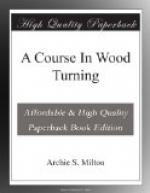CLASSIFICATION OF PLATES
A. Spindle turning
I. Exercises
1. Straight Cuts, a
2. Shoulder Cuts, a-b-c-d
3. Taper Cuts, a-b-c-d-e-f
4. V Cuts, a-b
5. Concave Cuts, a-b-c
6. Convex Cuts, a-b-c-d
7. Combination Cuts, a-b-c
II. Models
1. Chisel Handles, a-b-c-d-e-f-g
2. Mallets, a-b
3. Gavels, a-b-c-d
4. Stocking Darners, a-b-c
5. Potato Mashers, a-b
6. Rolling Pins, a-b
7. Vise Handles, a
III. Oval Turning
1. Screw-driver Handles, a-b
2. Hammer Handles, a-b
IV. Duplicate Turning
1. Indian Clubs, a-b
2. Dumb-bells, a-b
3. Tenpins, a
4. Drawer Pulls, a-b
B. Face-plate and chuck turning
I. Exercises
1. Straight Cuts, a-b
2. Shoulder Cuts, a-b
3. Taper Cuts, a-b
4. V Cuts, a-b
5. Concave Cuts, a-b
6. Convex Cuts, a-b
7. Combination Cuts, a-b-c
II. Face-Plate Models
1. Match Boxes, a-b-c
2. Pin Trays, a-b
3. Hair Pin Receivers, a-b
4. Hat Pin Receivers, a-b
5. Ornamental Vases, a-b-c
6. Spinnet, (game) a
III. Chuck Models
1. Towel Rings, a-b-c
2. Card Trays, a-b-c-d
3. Picture Frames, a-b-c-d
4. Nut Bowels, a-b-c-d
5. Napkin Rings, a-b-c
6. Jewel Boxes, a-b-c-d-e-f-g-h
7. Collar Boxes, a-b-c
8. Spheres, a
9. Checker Men, a
IV. Assembling Exercises
1. Candle Sticks, a-b-c-d-e
2. Shaving Stands, a-a’-b-b’
3. Reading Lamp Stands, a-b-c
4. Pedestals, a
5. Smoking Stands, a-b
6. Pin Cushions and Spool Holder, a
7. Chess Men, a-a’
V. Spiral Turning
1. Pedestal, (Single) a-a’, (Double)
b
2. Reading Lamps, (Single) a-a’-a’’
(Double) b-b’
3. Magazine Holder, a-a’
CHAPTER I
INTRODUCTORY
Wood turning has had a definite place in the commercial world for a great many years. It is used in various forms in making furniture and furniture parts, building trim, tool parts, toys, athletic paraphernalia and many other useful and beautiful articles in common use.
When properly taught in the schools it is one of the most valuable types of instruction. It appeals to pupils more than any other type of manual work, as it embodies both the play and work elements. It is very interesting and fascinating and, in the hands of a skilled instructor, is readily correlated with other work.
Wood turning gives a pupil preliminary experience necessary in pattern making and machine shop work. It brings into play the scientific element by demonstrating the laws governing revolving bodies. In bringing the chisel into contact with the revolving surface, the mathematical principle of the “point of tangency” is illustrated. Excellent tool technique is developed in wood turning as on the exactness




